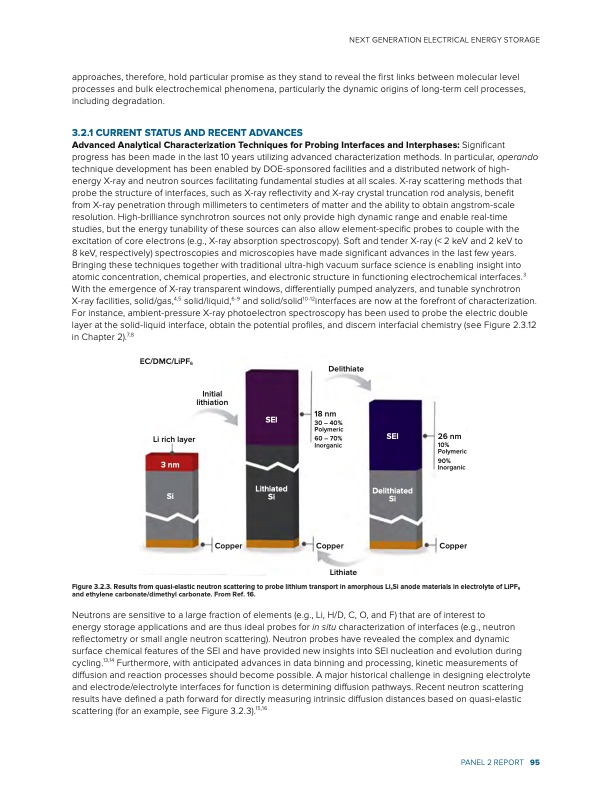
PDF Publication Title:
Text from PDF Page: 101
approaches, therefore, hold particular promise as they stand to reveal the first links between molecular level processes and bulk electrochemical phenomena, particularly the dynamic origins of long-term cell processes, including degradation. 3.2.1 CURRENT STATUS AND RECENT ADVANCES Advanced Analytical Characterization Techniques for Probing Interfaces and Interphases: Significant progress has been made in the last 10 years utilizing advanced characterization methods. In particular, operando technique development has been enabled by DOE-sponsored facilities and a distributed network of high- energy X-ray and neutron sources facilitating fundamental studies at all scales. X-ray scattering methods that probe the structure of interfaces, such as X-ray reflectivity and X-ray crystal truncation rod analysis, benefit from X-ray penetration through millimeters to centimeters of matter and the ability to obtain angstrom-scale resolution. High-brilliance synchrotron sources not only provide high dynamic range and enable real-time studies, but the energy tunability of these sources can also allow element-specific probes to couple with the excitation of core electrons (e.g., X-ray absorption spectroscopy). Soft and tender X-ray (< 2 keV and 2 keV to 8 keV, respectively) spectroscopies and microscopies have made significant advances in the last few years. Bringing these techniques together with traditional ultra-high vacuum surface science is enabling insight into atomic concentration, chemical properties, and electronic structure in functioning electrochemical interfaces.3 With the emergence of X-ray transparent windows, differentially pumped analyzers, and tunable synchrotron X-ray facilities, solid/gas,4,5 solid/liquid,6-9 and solid/solid10-12interfaces are now at the forefront of characterization. For instance, ambient-pressure X-ray photoelectron spectroscopy has been used to probe the electric double layer at the solid-liquid interface, obtain the potential profiles, and discern interfacial chemistry (see Figure 2.3.12 in Chapter 2).7,8 SEI Lithiated SEI Delithiated Si 26 nm 10% Polymeric 90% Inorganic Copper Figure 3.2.3. Results from quasi-elastic neutron scattering to probe lithium transport in amorphous LixSi anode materials in electrolyte of LiPF6 and ethylene carbonate/dimethyl carbonate. From Ref. 16. Neutrons are sensitive to a large fraction of elements (e.g., Li, H/D, C, O, and F) that are of interest to energy storage applications and are thus ideal probes for in situ characterization of interfaces (e.g., neutron reflectometry or small angle neutron scattering). Neutron probes have revealed the complex and dynamic surface chemical features of the SEI and have provided new insights into SEI nucleation and evolution during cycling.13,14 Furthermore, with anticipated advances in data binning and processing, kinetic measurements of diffusion and reaction processes should become possible. A major historical challenge in designing electrolyte and electrode/electrolyte interfaces for function is determining diffusion pathways. Recent neutron scattering results have defined a path forward for directly measuring intrinsic diffusion distances based on quasi-elastic scattering (for an example, see Figure 3.2.3).15,16 NEXT GENERATION ELECTRICAL ENERGY STORAGE EC/DMC/LiPF6 Initial lithiation Li rich layer 3 nm Si Si Copper Delithiate 18 nm 30 – 40% Polymeric 60 – 70% Inorganic Copper Lithiate PANEL 2 REPORT 95PDF Image | Next Generation Electrical Energy Storage

PDF Search Title:
Next Generation Electrical Energy StorageOriginal File Name Searched:
BRN-NGEES_rpt-low-res.pdfDIY PDF Search: Google It | Yahoo | Bing
Sulfur Deposition on Carbon Nanofibers using Supercritical CO2 Sulfur Deposition on Carbon Nanofibers using Supercritical CO2. Gamma sulfur also known as mother of pearl sulfur and nacreous sulfur... More Info
CO2 Organic Rankine Cycle Experimenter Platform The supercritical CO2 phase change system is both a heat pump and organic rankine cycle which can be used for those purposes and as a supercritical extractor for advanced subcritical and supercritical extraction technology. Uses include producing nanoparticles, precious metal CO2 extraction, lithium battery recycling, and other applications... More Info
| CONTACT TEL: 608-238-6001 Email: greg@infinityturbine.com | RSS | AMP |